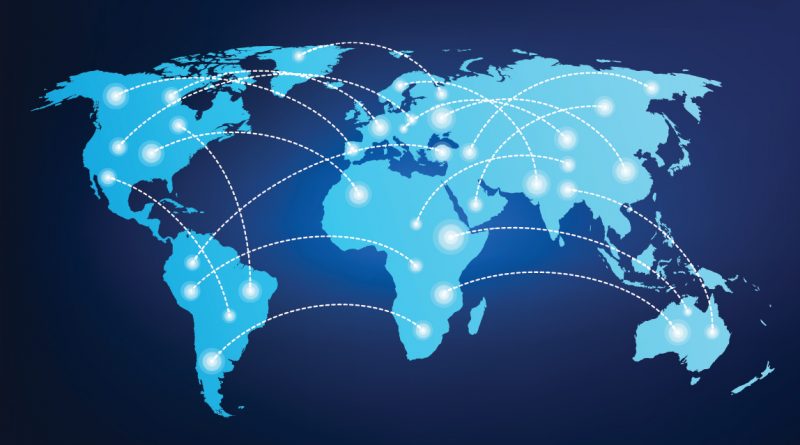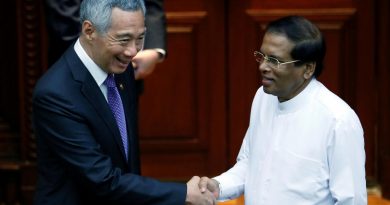TPP 11: How Asia took the lead in free trade (Nikkei)
The trans-Pacific pact will help business, but hopes remain for a US return
YASU OTA, Nikkei Asian Review columnist, SHUICHI MARUYAMA, Nikkei staff writer

A container ship in Singapore: The trade-dependent city-state hopes the TPP 11 will provide an economic tailwind. © Reuters
SINGAPORE/MEXICO CITY — Duong Ngoc Minh is sometimes called Vietnam’s “Catfish King” for his role in creating a global market for panga, a fish known for its low price, white flesh and mild flavor. A type of shark catfish, the panga thrives in crowded aquafarms scattered throughout Vietnam’s Mekong Delta region, resulting in plentiful fish at minimal costs. And as the world’s appetite for seafood has grown in recent years, so has Minh’s 15-year-old company, Hung Vuong, the country’s leading panga exporter.
Minh, like others in Vietnam’s fisheries industry, initially had high hopes for the Trans-Pacific Partnership, seeing it as a way to gain even greater access to the U.S. market. But after U.S. President Donald Trump pulled out of the trade agreement last year, Minh has been forced to recalibrate his expectations.
While the U.S. will remain a “big and important” export market for his company and for Vietnam, Minh says maintaining Hung Vuong’s current levels of business there will be a challenge, given Trump’s “America first” trade policies.
Yet even without U.S. participation, Minh says his company will still benefit from the Comprehensive and Progressive Agreement for Trans-Pacific Partnership, as the pact is now known. He sold $20 million worth of seafood to Japan, Canada and Australia last year, but hopes to eventually increase that by 30% after the final agreement is signed among the so-called TPP 11 countries at a ceremony in Santiago, Chile, on March 8.
The near-collapse of the TPP was a blow to Vietnam. The country had been hoping to dramatically increase its exports of clothes, shoes and agricultural and fishery products to the U.S., the country’s largest export market, as well as Canada, Mexico and other countries in the partnership. But the agreement still stands to be potentially transformative for Vietnam, allowing it to boost its level of economic advancement far more quickly than it would have otherwise, trade analysts say.

Vietnamese workers make panga fillets at a Mekong Delta seafood factory in July 2017. © Reuters
Yet what is perhaps most significant about the CPTPP is not the details of the accord but the fact that its members were able to come to an agreement without the U.S., for decades the world’s leading proponent of free trade. The widespread assumption was that the TPP would collapse without the U.S., but Japan and others kept pushing — and its success in driving the agreement was a surprise to many.
The backdrop to the ceremony in Santiago could not be starker. As 11 countries, including communist Vietnam, were set to sign the most significant free trade agreement in 25 years, the U.S. president was rattling global markets and alarming American allies with his talk of steep tariffs on steel and aluminum.
“It shows how upside-down our world has become that the U.S. — which drove the [TPP] initiative from the early days, stood to benefit from it significantly and will be harmed by being out of it — has pulled out and gone in the completely opposite direction,” said Deborah Elms, executive director of the Asian Trade Center in Singapore. “The U.S. has ceded its leadership on trade to Asia.”
The CPTPP covers 500 million people and has a collective GDP of $12.4 trillion. Though still huge, accounting for 13.5% of global GDP, it is less than half of the 38.2% under the TPP with U.S. participation.

The original TPP deal was agreed in October 2015 by 12 members, including the U.S. When the U.S. left, the deal lost its carefully maintained balance built on mutual concessions. The remaining parties did not want to sign it as it was, so the pact had to be reworked.
Member countries in Asia and Oceania wanted to rid the agreement of some sections that the U.S. pushed hard for and won, including on intellectual property. With the U.S. out, reckoned the countries, it no longer made sense to pay the extra costs under those clauses because they would not improve access to the U.S. market, the largest export destination for their goods and services.
So the 11 countries worked to find a new balance among themselves. Roughly 20 clauses that the U.S. had pushed for were “frozen” under the revised agreement. Among them were a proposed eight-year protection for data on next-generation biological medicines and extensions of copyright protection to 70 years after an author’s death.

It appears that the members stepped back a little from strengthening trade rules. But it is significant that they left in the revised agreement rules ensuring freedom in digital activity, including three principles regarding electronic trade: cross-border transfer of information, a ban on member states requiring foreign entities to set up computer servers in the states’ territory, and a ban on states ordering software source code disclosure.
While Trump appears determined to protect declining 20th century industries like steel and coal, the 11 CPTPP countries have enshrined a set of brand-new rules on digital freedom. The principles may prompt multinationals to enter Asia’s burgeoning economies. They also may speed up their big data capabilities, which could help drive innovation in artificial intelligence.
“We haven’t had an agreement since NAFTA that is as deep and as broad and as comprehensive as TPP,” said the Asian Trade Center’s Elms, referring to the 1994 North American Free Trade Agreement. “Once it comes into force, which could be this year, it could transform business for the TPP members.”

A Chilean port worker checks a copper shipment bound for Asia. © Reuters
Sense of urgency in Mexico
In mid-February, Mexico’s Economy Minister Ildefonso Guajardo rhapsodized over the benefits the TPP 11 would bring to the country’s economy. It would open six new markets in Asia and allow Mexico to boost exports of food items such as pork, avocados, tomatoes and tropical fruits, he told members of the federal upper house.
Mexico is no stranger to free trade deals, having signed such accords with 46 countries, including Japan. But the TPP 11 represents an important opportunity for the country to establish trade relations with many new governments, including Australia, New Zealand, Brunei, Malaysia, Singapore and Vietnam. The existing deals are mostly with the Americas and European countries.
Guajardo’s enthusiasm for expanding Mexico’s trading partners is not surprising given the country’s difficult relationship with its northern neighbor. Trump has called NAFTA — which eliminated tariffs between Mexico, the U.S. and Canada — a “disaster” and forced the partners to enter negotiations to redraw the agreement. As the three countries were wrapping up the seventh round of talks on the deal on March 5, Trump sought to add pressure on Canada and Mexico by saying they could avoid his planned steel tariffs only if a new NAFTA deal was struck with the U.S.
For Mexico, NAFTA prompted an influx of U.S. manufacturers seeking to employ its plentiful low-wage workers. As a result, the Mexican economy grew as it became a production base for the U.S. market. Today, Mexico’s economy is heavily reliant on the neighboring country: The U.S. represented 80% of Mexico’s exports and 46% of its imports in 2017.

A worker sorts avocados at a plant in Tacambaro, Mexico, in June 2017. © Reuters
Worried that its NAFTA-dependent economic model may break down under Trump’s agenda, Mexico is trying to diversify its economy. Mexican President Enrique Pena Nieto has called for expanding both its export markets and the scope of foreign investors to countries other than the U.S. In 2017, the share of the U.S. in Mexico’s exports declined 1.1 percentage points from a year earlier, although the U.S. remains by far the biggest importer of Mexican exports by value.
The TPP 11 will help Mexico diversify its trading partners, but it is unclear how far it will go toward weaning the country off its reliance on the U.S. Yet its strategic value is clear: The Mexican government thinks having other trading partners to fall back on will give it more leverage in renegotiating NAFTA. The hope is to challenge the U.S. assumption that Mexico would not be able to maintain its economy without NAFTA and thus be submissive to its demands.
“Huge upsides” for Vietnam
Of all the countries involved in the original TPP, Vietnam was poised to be perhaps its biggest winner. Its clothing and textiles industry was projected to grow by 30% a year thanks to improved access to the U.S. market, from 10% to 12% today. Selling to its new CPTPP partners will still boost sales, but the rise may not be as dramatic.
For Vietnam’s seafood industry, the biggest impact of the CPTPP may well be improving quality. The country’s fish — particularly its panga — have been the subject of attacks in Europe and the U.S. over food safety and farming conditions. (In February, Vietnam struck back, filing a case against the U.S. for what it called punitive tariffs on its fish, including new rules requiring panga to be inspected by both the U.S. Department of Agriculture and the U.S. Food and Drug Administration.)

The U.S. sent a message to China by dispatching the USS Carl Vinson aircraft carrier to the southern Vietnamese port city of Danang on March 5. © Reuters
But the CPTPP could improve the reputation of Vietnam’s fish. Japan has had high tariffs on seafood, meaning it made little sense for companies to invest the money in techniques that would ensure their catch was up to their high standards. “If those tariffs drop to zero, suddenly there are incentives to figure out how to clear the challenging standards to sell in Japan,” Elms said. “The upsides of being in Japan are huge” for Vietnam.
Vietnam was eager to conclude the CPTPP in part because it believes a revised deal would encourage the U.S. to return to the fold — improving its exports while also deepening ties to a country it sees as an important counterweight to China.
Vietnam wants a strong U.S. presence in Asia, not least to pressure China, which has been increasing its military presence in the South China Sea and pushing its Belt and Road Initiative designed to expand its economic influence beyond its borders. Just a few days before the Santiago signing ceremony, the USS Carl Vinson aircraft carrier anchored off the Vietnamese port city of Danang, marking the largest U.S. military presence in the country since the war between the two countries ended in 1975. China’s military buildup in the Paracel Islands and construction of seven artificial islands in the Spratlys has worried Vietnam.
Japan played a major role in keeping Vietnam interested in the trade deal by maintaining close contact after the U.S. withdrawal to underscore the deal’s importance in terms of national security.
Vietnam is not the only CPTPP country that would like to see the U.S. return to the trade agreement. Trump gave them hope when he hinted in January that he might return if he could get a better deal, a sentiment echoed recently by his Treasury secretary, Steven Mnuchin. Members of the U.S. Congress are beginning to press the Trump administration to reconsider its approach to trade, especially as the costs of a possible withdrawal from NAFTA become clearer, Elms said.
“This is going to be slow and painful, but there is discussion in Washington of the economic costs of being out [of the TPP], especially when key competing nations are in,” she said. “The assumption was that when the U.S. pulled out, the agreement would fall over. The reality is they did it, and this agreement is starting to really focus attention on the [American] people negatively affected, including agricultural interests.”
The CPTPP may or may not bring immediate economic benefits to member countries. But it does send a clear signal that the 11 nations in Asia and Latin America have cast their lot with free trade — and said no Trump’s “America first” policy.
Kim Dung Tong in Ho Chi Minh City contributed to this article.





